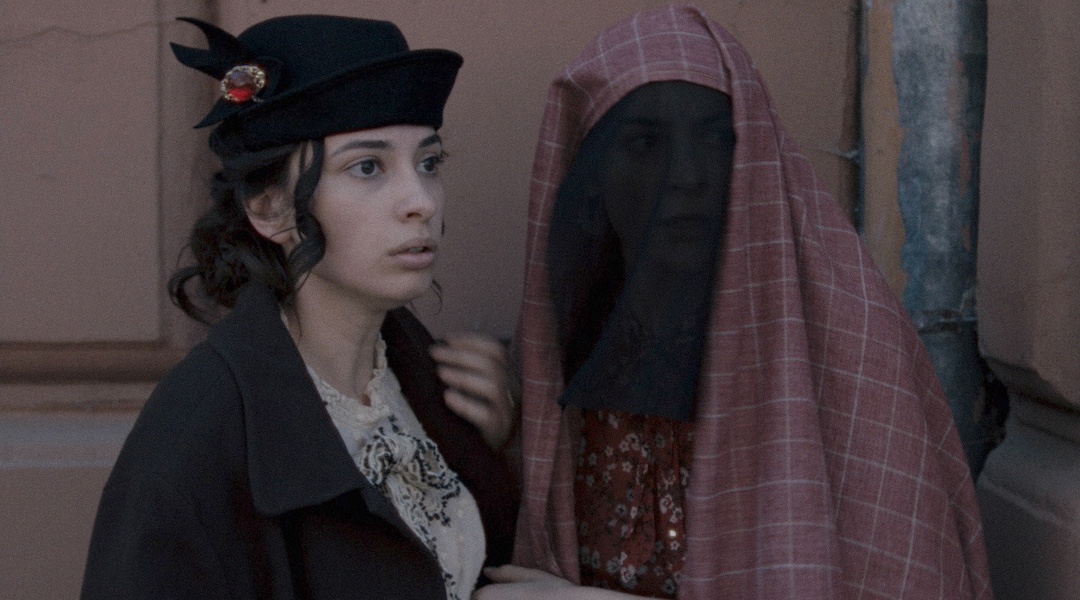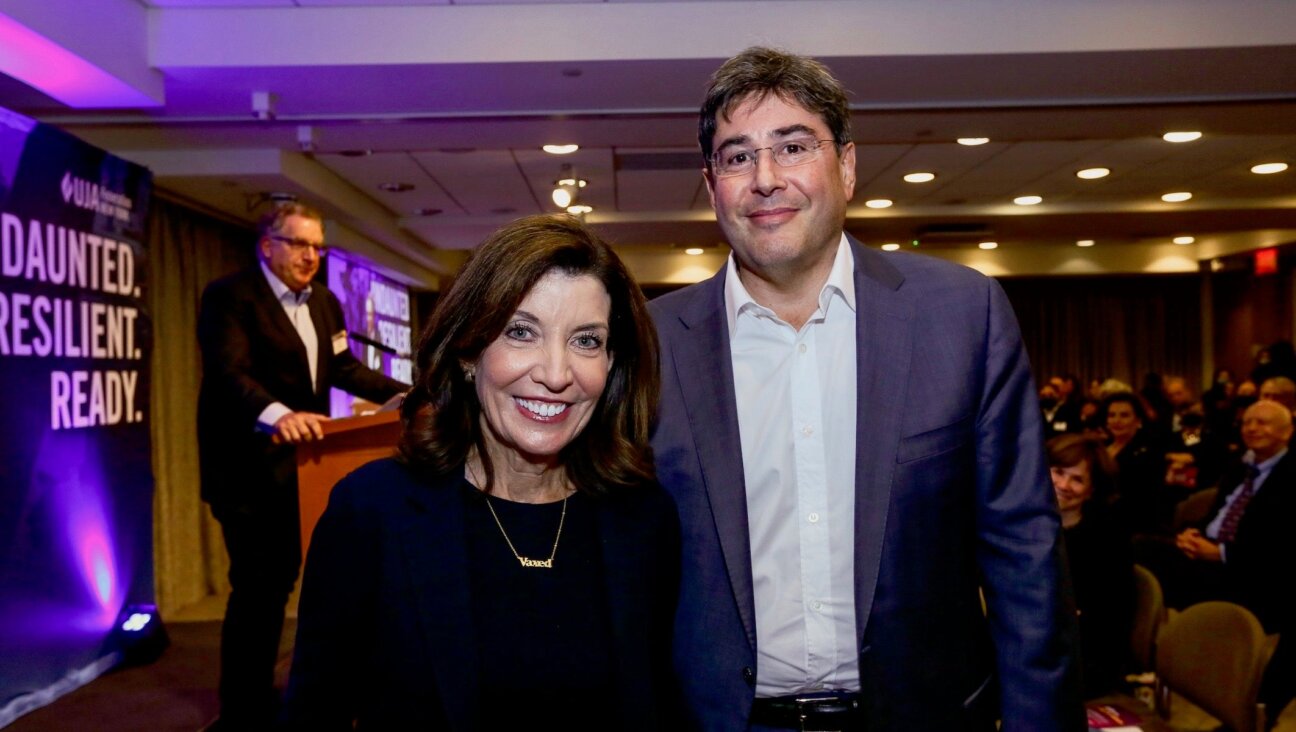A Muslim family saved a Jewish one from the Nazis. 50 years later, the Jewish family returned the favor in Sarajevo.
The short film “Sevap/Mitzvah,” which is eligible for Oscar contention, tells a remarkable true story

A still from “Sevap/Mitzvah.” (©geminisnakeproductions)
(JTA) — In 1941 Sarajevo, a Muslim woman hid her Jewish friend from fascist roundups. Half a century later, that same Muslim woman was trapped in the besieged capital during the 1992-1995 Bosnian War — and her Jewish friend made sure she got out.
These real events inspired “Sevap/Mitzvah,” a short film directed by Sabina Vajrača that won the 2023 Humanitas Prize, among other awards, and has qualified to be considered for the 2024 Oscar for best live action short.
The film has been shown across the world, including at the Cleveland International Film Festival and the Joyce Forum Jewish Short Film Festival in San Diego. Upcoming screenings include the Centre Film Festival in Phillipsburg, Pennsylvania, on Nov. 1; the Ojai Film Festival in Ojai, California, on Nov. 5; and the Lake County Film Festival in Grayslake, Illinois, between Nov. 3-12.
The Arabic word “Sevap” and the Hebrew word “Mitzvah” translate to the same meaning: A good deed.
“I wanted to tell a story about Jews and Muslims coexisting peacefully and happily, and helping one another, which is the narrative that we don’t really hear,” Vajrača told the Jewish Telegraphic Agency. Vajrača herself escaped the Bosnian War as a teenager, arriving in the United States as a refugee.
As the Nazis invaded Yugoslavia in April 1941, Sarajevo was heavily bombed, its synagogue looted and 400-year-old Torah scrolls burned. The Jewish Kabiljo family was among those who fled to the forests and returned to find their home destroyed.
A couple of Muslim friends and neighbors, Mustafa and Zejneba Hardaga, offered the Kabiljos shelter in their home. At the risk of their own execution, the Hardagas hid Josef Kabiljo, his wife Rifka and their two children from the Gestapo and the Ustaša — the fascist movement that ruled the regions of Croatia and Bosnia and Herzegovina during World War II.
According to their faith, the women in the Hardaga family covered their faces with a veil in front of men who were not their family. But to signal that the Kabiljos were welcome, Mustafa Hardaga told Zejneba and her sister-in-law Bachriya that they could remove their veils before Josef Kabiljo.
Josef later testified to Yad Vashem, Israel’s Holocaust memorial authority: “Never before had a strange man stayed with them. They welcomed us with the words: ‘Josef, you are our brother, and your children are like our children. Feel at home and whatever we own is yours.’”
The Ustaša set out to purge its state of Serbs, Jews and Roma through labor and death camps. By the end of the war, they succeeded in murdering 12,000 of Bosnia’s 14,000 Jews. But the Kabiljo family survived, eventually making their way to Israel.

Filmmaker Sabina Vajrača was 14 during the Bosnian War. (Joshua Sarlo)
Fifty years later, 76-year-old Zejneba Hardaga found herself at the center of another genocide in Sarajevo. (By that time, her husband had died.) Serb forces embarked on a campaign to rid Bosnia of non-Serbs, the majority of whom were Bosnian Muslims, also known as Bosniaks. Sarajevo was blockaded from food, water and power between April 1992 and February 1996 — the longest siege in modern history.
Hardaga sheltered in a basement with her daughter, son-in-law and granddaughter, subsisting for weeks at a time on soup made of grass they picked nearby. Outside, Sarajevo was shelled daily and snipers targeted people leaving their homes. Over 11,000 people were killed during the siege.
In Jerusalem, Rifka Kabiljo and her family were watching Bosnia’s devastation on the news. They contacted an Israeli journalist who was covering the war, asking him to confirm that Hardaga was alive.
Upon learning she was still in Sarajevo, the Kabiljos appealed for help from Yad Vashem, which had recognized Hardaga and her family as Righteous Among the Nations in 1984.
Yad Vashem’s authority did not sway the president of Bosnia, so the Kabiljos took their case all the way to Israeli Prime Minister Yitzchak Rabin.
In early 1994, the Hardagas joined 300 others in a convoy of six buses leaving Sarajevo — the last rescue of mostly Jewish refugees organized by the American Jewish Joint Distribution Committee and Sarajevo’s Jewish community. The family was given a choice of destinations, and Zejneba chose to join her friend Rifka in Israel. She died there a year later.
Vajrača, a Bosnian Muslim, started thinking about stories of Jews and Muslims who rescued each other during a conversation with her late grandmother — who admitted that she was haunted by her failure to save a childhood best friend. One morning in 1941, when she was about 9 years old, she watched from a window as her Jewish friend who lived next-door was rounded up with her family. Vajrača’s grandmother tried to run outside but her parents held her back, saying it was dangerous outside. The Jewish girl and her family died in a concentration camp.
“She said to me, ‘I remembered it because 50 years later, they knocked on my door and came for me,’” recounted Vajrača, whose grandmother survived the Bosnian War. “‘They took me, and I thought, perhaps if we had saved them 50 years ago this wouldn’t have happened.’”
Vajrača was 14 years old when her northern Bosnian town was overrun by Serb forces. Her family was quickly targeted, as her father worked in humanitarian aid for victims of the war. In retaliation, the Serbs threatened to take Vajrača to a concentration camp, where women and girls were systematically raped. Her parents asked everyone they knew for help getting her out of the country.
“In the end, the people who saved me were two women, both Christian — one Croatian and one Serb,” Vajrača told JTA. “They’re the ones who saved my life, even at the risk of their own. So the story that I tell in this film is personal in that way, that it happened to me as well.”
Zejneba Hardaga’s daughter, Sara Pecanac, still lives in Jerusalem. She converted to Judaism and worked at Yad Vashem for many years.
In a 2013 interview, Pecanac recalled how her mother asked to meet Rabin a few months after their arrival. After a bit of chatting, Hardaga said she wanted to offer Rabin some advice.
“The whole place went quiet,” said Pecananc. “Who was this old woman to give advice to the prime minister of Israel? He said ‘OK,’ and she said, ‘Please, try to make peace in the Middle East. Don’t let Jerusalem become Sarajevo.’”
This article originally appeared on JTA.org.






















